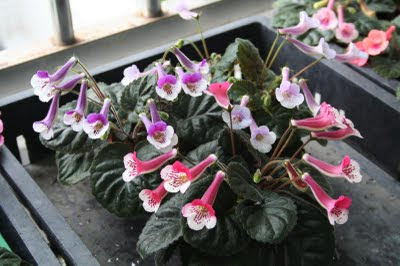 |
| Mini Sinningias from Pirate's Playground |
Story # 8,
We just don’t know which half!
The florist Gloxinia (Sinningia speciosa) is excluded from this discussion. There are very good ones produced from seed or tissue culture. Their commercial problems have always been large size (therefore, expensive), brittleness (breakage), or cold water damage (marked leaves, therefore, unsalable).
Mini Sinningias have never had any systematic performance testing. Hybrids have been made and selected by the originator based on their own selection criteria. If hybrids are sterile then they are doomed to limited distribution. Even if they are fertile they have not been purified into a dependable seed line (many offspring have low bud count or inconsistent flower size). An answer is tissue culture.
If selected varieties can be produced by tissue culture (thereby, an identical clone to the parent) in commercial quantities, then the market can be tested.
This is where I am.
Mini-Sinns, like Episcias and to some point like Streps have "enthusuastic" folks who think their "babies" are "special" and therefore need to be Registered.
ReplyDeleteWhile I've kept a number of my own hybrids, I've never Registered any because they failed at one or more of the following:
Markedly different from what's currently available
Propagates easily
Adapts to a wide range of conditions
Fail any or mult of the above and I don't think they should be sold...
Cheers,
Pat
Pat,
DeleteHybridizing plants is a technique, but selecting them is the Art. Every hybridizer can use their own evaluation system. Maybe you have some that should see the light of day.
Gary